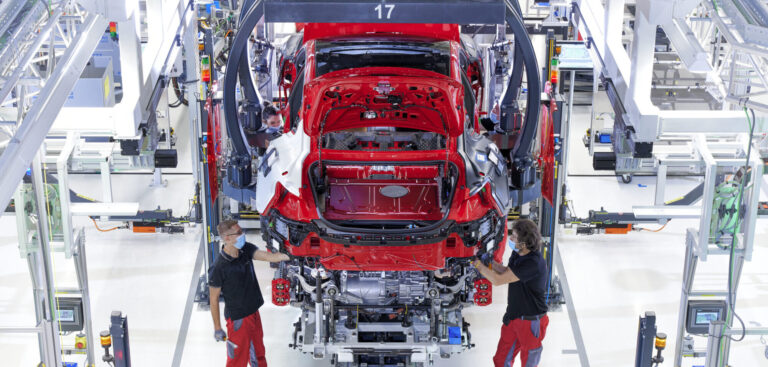Audi has launched its latest EV, the e-tron GT, alongside a high-performance RS model. In GT form, the car features a 175kW front motor and a 320kW rear drive, with the RS version upping rear motor output to 335kW. Audi notes that total output of the system is limited to 350kW in the GT, though a boost to 390kW is available on launch. The RS variant, meanwhile, is capable of a constant 440kW and 475kW in boost mode.
Audi claims that the PSMs (permanently excited synchronous motors) in the e-tron GT are its most efficient yet, with the motors, power electronics and transmission housed in integrated units on each axle. At the rear, motor drive is transmitted via a two-speed transmission, providing a low ratio for acceleration and a higher second ratio for improved cruising efficiency.
The 86kWh (93kWh gross) battery pack is located in the floor of the vehicle, between the axles, in order to benefit weight distribution; 30 modules form the lower level of the pack, which features a wide recess in the rear section creating space for the rear passengers’ feet. The upper level of the battery contains three further modules situated below the rear seats.
Beneath the cells is a compound structure of flat extruded sections through which coolant flows that circulates in its own low-temperature circuit. The connections, fuses, and the main control unit are located under the center console. Audi notes that running the system at 800V enables a high continuous output and shortens the charging duration while also reducing the weight of, and space required for, the wiring. The inner structure of the battery container, the frame surrounding it and the cover plates are made of aluminum. Audi highlights that the battery system contributes significantly to the rigidity and crash safety of the main vehicle body to which it is attached.
Four separate coolant circuits regulate the temperature in the high-voltage components of the powertrain and the vehicle interior. These can be interconnected flexibly when required. For example, if the driver demands a high output several times in a row, valves couple the coolant circuit of the battery with the refrigerant circuit of the air conditioning system.
The refrigerant circuit also helps with cooling during fast-DC charging. At a sufficiently powerful DC terminal, the electric coupe can achieve a peak charging capacity of up to 270kW, with charging from 5% to 80% SoC (state of charge) taking less than 23 minutes in ideal conditions.


